Basel Yazouri: Operation Protective Edge in Gaza
How an 18-year-old Palestinian prodigy came to train his lens on last summer’s Israel-Hamas hostilities, which ended one year ago today
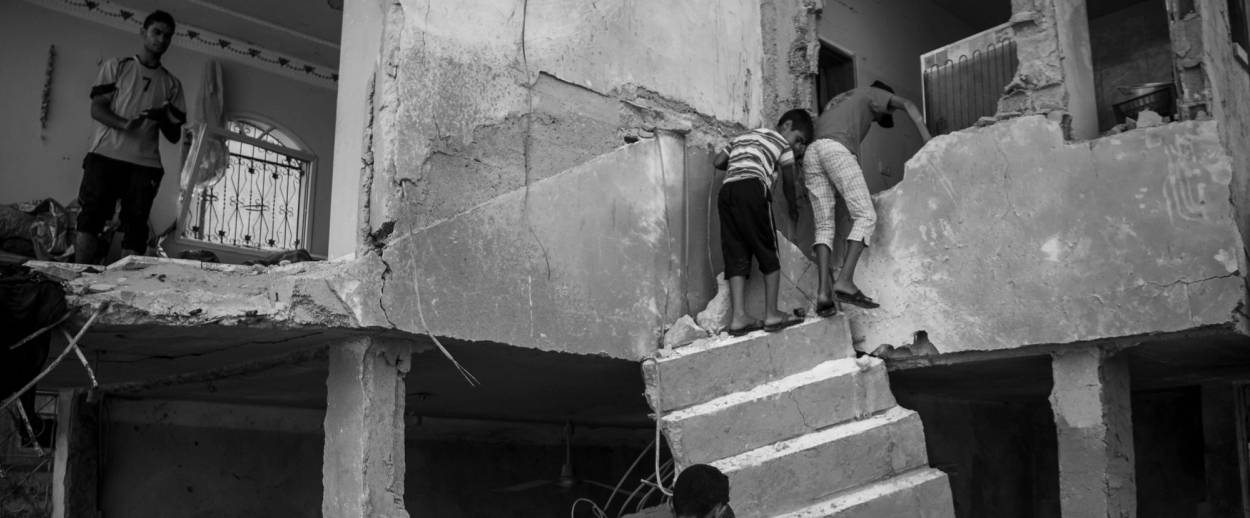
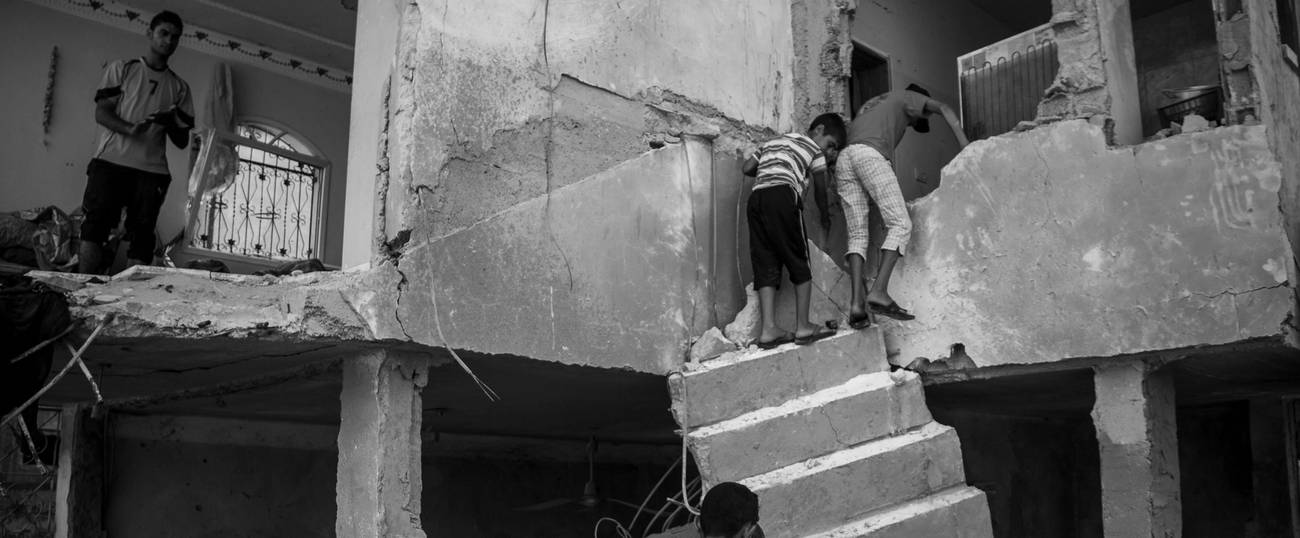


“Prodigies in photography are singularly rare,” observed art historian Abigail Solomon-Godeau, in a seminal essay about Francesca Woodman, a photographer who committed suicide at the age of 23. Her words immediately sprang to mind when I first encountered the photographs of Basel Yazouri, an 18-year-old from the Gaza Strip.
In January, Yazouri became the youngest-ever recipient of the prestigious Magnum Foundation Human Rights Fellowship, in part for his work during the 51-day Israeli military action in Gaza last summer, when he photographed the crowded, bleak terrain of Gaza, documenting the impact of the conflict at home. He was 17 years old, completely self-taught, with no training operating a camera and little familiarity with other photographers’ work, yet he created an incisive, visually arresting, and strikingly mature photographic record of life in Gaza during the invasion. Of that formative time, he told me recently in New York, where he now lives, “I didn’t remove my finger from the shutter for 51 days.”
On the one-year anniversary of the Egypt-brokered ceasefire between Hamas and Israel, we are presenting a slideshow of Yazouri’s photographs, many published here for the first time, all taken during Operation Protective Edge. The photo essay, published with photographer’s captions, announces a prodigious new talent in the field of documentary photography.
***
Yazouri was born to a secular, Muslim, educated family and raised in Gaza City and Rafah. His mother, a prominent dentist who serves as the chief of dentistry in the Gaza Strip for UNRWA, was born in Gaza City. His father, a businessman who was born in Rafah, held important positions in the Palestinian National Authority and was responsible for the Palestinian Human Rights File for the Arab League until Hamas took control of Gaza. Yazouri’s grandparents were born in Beit Daras (now Moshav Giv’ati), near Ashdod, and fled to Gaza in 1948.
Three years ago, Yazouri’s older sister Jeneen asked their mother to buy her a camera because she wanted to become a photographer—a profession prohibited to her by Hamas—even though there were no photography courses available to her in Gaza. The mother brought back a little digital Canon 600 from a business trip to Dubai, but Jeneen never got to use it. Once Basel picked it up, he never put it down.
His first attempts at photography centered on the importance of the sea and coastline to daily life in Gaza by capturing the quotidian routines of fishermen. In these early photographs, grids of fishing net are spread out against the sea’s horizon line and fishermen work along the craggy boulders that shoulder the coastline or against a backdrop of modest, colorful, and corroded fishing boats. These early experiments with framing and composition reflect an artistic sensibility while offering an intimate and substantive commentary on the fishing economy in Gaza. They show a world that seems disconnected from the war-torn landscape that he would document only 18 months later.
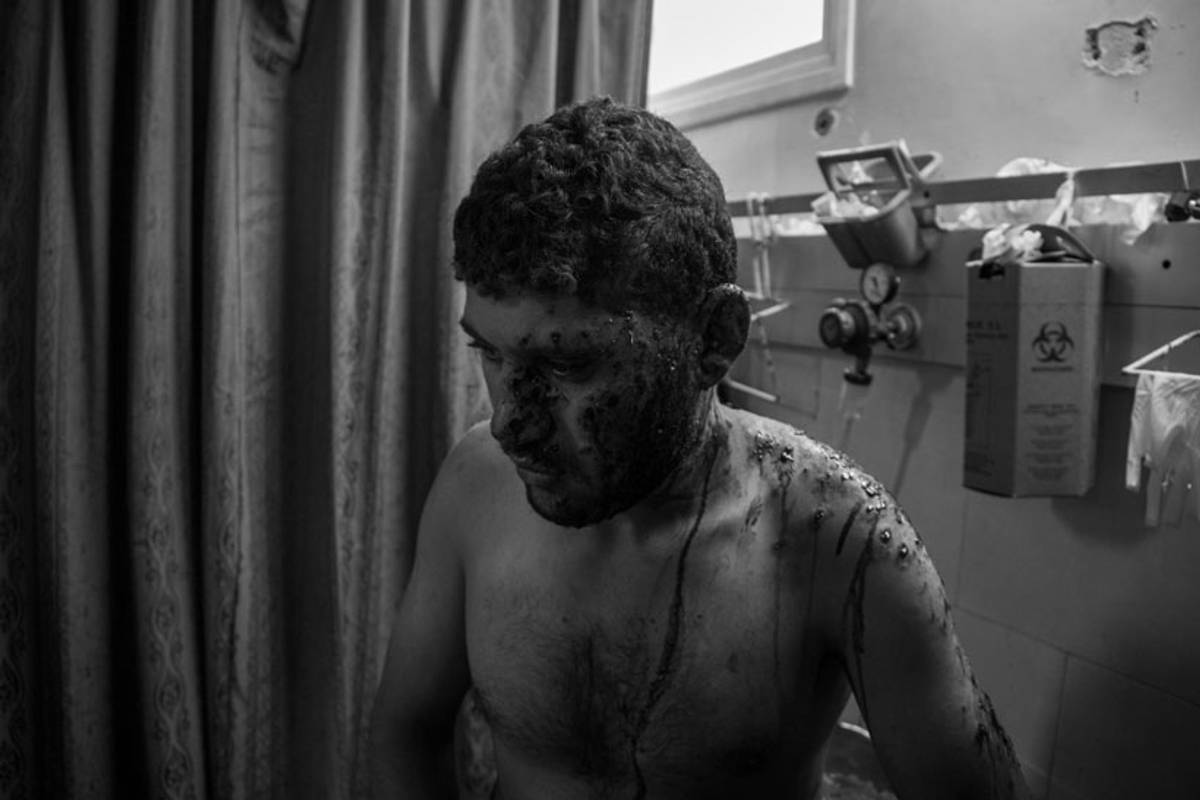
A few months after he first held a camera in his hands, learning, he said, “through trial and error,” Yazouri became a contributor to ActiveStills, a collective of Palestinian, Israeli, and international documentary photographers. In 2013, at age 16, Yazouri became its youngest member when he published an inventive photo essay documenting Palestinian youth culture. His color-saturated images of teenagers—mostly boys his own age—attempting to find outlets for the oppressive stress of living in Gaza reveal an instinctive compositional acuity. He photographed Gazan surfers, rappers, sprawling bachelor parties, hip-hop dancers, thrumming music parties, and, in his most accomplished series (with ActiveStills member Anne Paq), parkour, an aerial melding of acrobatics and hip-hop dancing. Yazouri captured young Gazans hurtling through the air in dynamic, nearly impossible gravity-defying positions in the crowded streets. Some of these figures recall Aaron Siskind’s 1950s photographs of young divers cutting bold geometric forms against a white background. They are the work of a precocious, gifted young photographer.
When he started taking photographs, Yazouri wanted to document the daily lives of people in Gaza rather than focusing on the bombings, ruins, and destruction. “There are so many talented people in Gaza,” he said, “but no one will show the guy doing parkour, living his life. They only want to show the destruction, and I wanted to show how I think about my home.” Even after hostilities broke out last summer, Yazouri wanted to continue to show the daily life of Gazans during the attacks, the interactions of the people on the street, and Palestinian youth culture.
Although he had never before traveled outside of Gaza, Yazouri’s command of English encompasses an advanced vocabulary that would be the envy of most Americans his age. He learned the language, he said, listening to American rap music—which he also performs—especially that of Eminem, as well as Tupac Shakur, Big L, Dr. Dre, Notorious BIG, Eazy-E, and Ice Cube. He is a gifted listener and storyteller with strong opinions, an open mind, and a sensitive appreciation for nuance, all of which inform his photographs. He is also preternaturally mature and well-read, with a sharp intellect and broad range of interests. Conversations with him bounce easily from contemporary politics, philosophy, art, and economics, to Nietzsche, Sartre, Viktor Frankl, the Old Testament, and ancient history, and it is easy to forget that you are talking to an 18-year-old who has, until recently, lived his entire life in a 7-mile wide swath of land.
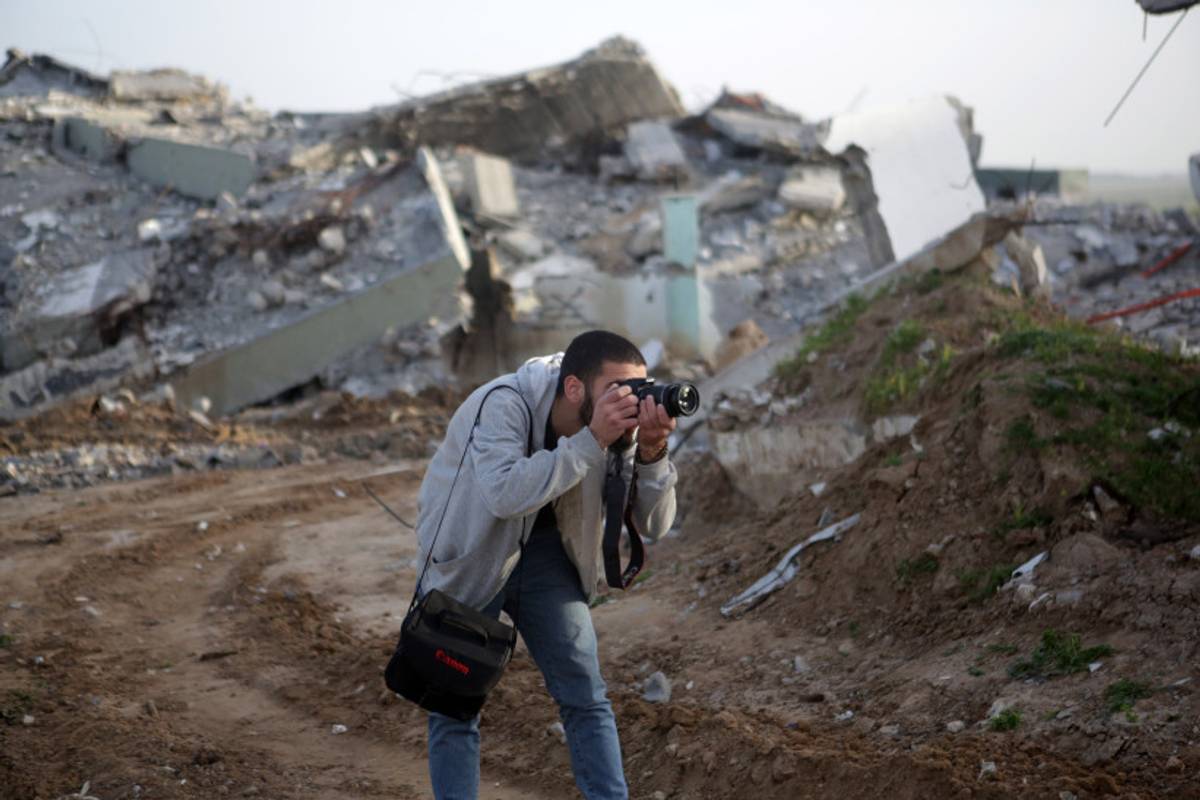
During last summer’s conflict, Yazouri produced several thousand black-and-white and color photographs taken throughout Gaza Strip. In January, on the advice of his brother, who had photographer friends in Egypt, Yazouri gathered a small portfolio of work—just 15 images—and sent his application to the Magnum Foundation in New York. Most of Magnum Foundation’s Human Rights fellows are in their mid-20s to early-30s (the average age is 27), and the foundation received nearly 500 applicants for only seven slots. “I am eager to challenge injustice and to use my photography in the struggle to have more equality in the society in which I live,” Yazouri wrote in his application. “The passion to document people’s lives, uncovering the various issues they are facing and exposing how their rights are neglected and abused, are the reasons that make me hold the camera.” He became the youngest person, and the first Palestinian (from Gaza or the West Bank), to be awarded the important fellowship. (Magnum Photos, the most influential and fabled photography cooperative in the world, does not yet have a Palestinian member.)
For Susan Meiselas, the legendary photographer and current president of the Magnum Foundation, what made Basel stand out among applicants was his “level of engagement, being immersed in the situation but looking at it critically, having the capacity to both immerse and engage, an important quality that you can see in his work.”
At first glance, Yazouri’s pictures of Gaza recall a broader body of photographic images that were reproduced last summer in media outlets large and small across the world: Photographs of collapsed buildings, overcrowded hospitals, mounds of rubble, and the dead and injured accompanied news stories about mass casualties, food shortages, widespread homelessness, curfews, and people living without electricity and water. Yazouri’s photographs, like many that were taken in Gaza last summer, portray a world of despair, suffering, and destruction. What is exceptional about this teenage photographer’s images is that they focus not on the devastation of the land but on the lives of the people who are being affected.
When you look at his photographs, your eye settles not on a bombed-out building, but on the boy holding a kite, the expressions of the faces in the crowd, the varied postures of men surveying the damage, or the domestic interiors still visible in the ruins: an overstuffed velvet sofa; a picture hanging at an angle; a light fixture above a tufted, ornate chair, where the rest of the home has been reduced to rubble. There is a voyeuristic pull in seeing the interior of someone’s home displayed without the occupant’s permission. One cannot help but think about the family that had just sat down to the table, because the image portrays a table that was left mid-meal.
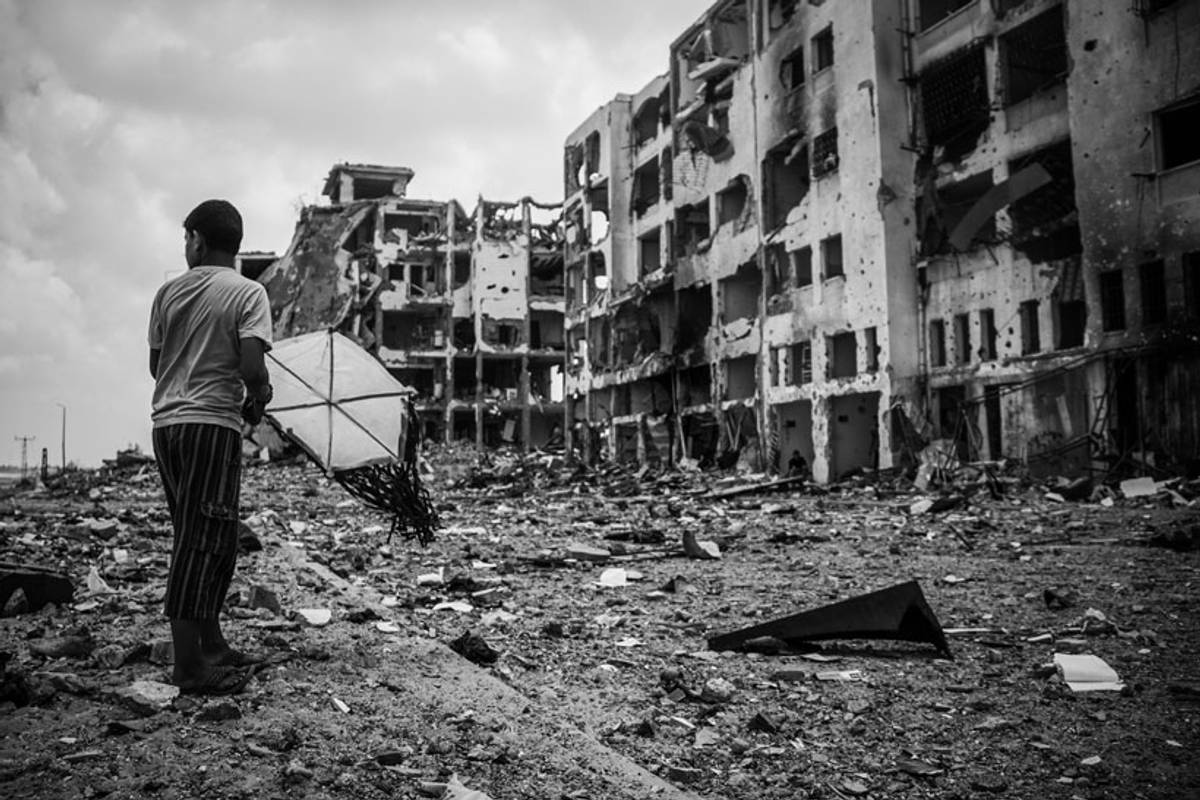
Yazouri has a keen eye for textures, patterns, the sharp graphics on a flag against the ornate pattern of the rug, the jagged staircase bisecting the frame, the rhythm of shapes that create a carefully balanced composition. Even in his photos of rubble, there is a movement and dynamism to the composition that keep the eye moving throughout the frame; it is not easy to settle in, and so it is not as easy to turn the page. A man weeping over the body of his child is not tightly cropped to make the act of mourning the subject. Rather, he has his back against a bare wall and is cornered into a room with the wrapped body of the child at his feet; the photographer has left ample, empty space in the frame to communicate the emptiness and sorrow of the parent who has lost an entire world.
In many images, careful, sustained looking rewards the viewer with surprises that challenge first-glance assumptions. Two men, their faces mostly covered by black cloth, rummage through a small, disheveled room. The man in the foreground has a violent expression, or so it reads through the mask, which one assumes is meant to protect the man’s identity. When studying the image, one slowly realizes that the men are surrounded by rotting bodies that have been haphazardly wrapped and stored in a farmer’s vegetable and flower cooler. From the context, one can deduce that the hospitals are overcrowded, and the men cover their noses and mouths to mask the stench. In another example, a group of strong young men stand together, their backs to the camera, in a line looking at a building, half of which has crumbled. But a more careful look reveals a few air conditioners that are dangling, dangerously from the ruins. And upon further examination of the image, one notices a body hanging from the debris, as well; and yet, this is not where Yazouri focused his lens.
“He captures the delicate moments of life in the midst of destruction, he is creating a landscape, he is placing you in the world of those who are suffering, perhaps the most, by the impossibility of this war and the lack of dialogue that exists,” Meiselas, who has become one of his mentors, observed. “That is a key quality. Very often when you see young photographers looking at something, the victim is filling the frame, but Basel is creating complex scenes.”
Last June, Yazouri packed for a six-week trip to the United States as part of his Magnum Foundation fellowship. In July, largely through the efforts of people at the foundation, he had been offered a four-year, fully funded scholarship to Bard College and a chance to stay in the United States. And in September, Yazouri will begin his undergraduate studies at one of the best photography departments in the country. “Whenever possible, we try to extend ourselves to help talented and ambitious students and future leaders, and in Basel Yazouri we see just such a student,” commented Bard College President Leon Botstein, noting that Yazouri was brought to Bard’s attention by “some of our most esteemed colleagues and faculty in photography and photojournalism.” This week Yazouri is moving into a freshman dorm room on the college’s sprawling campus in Annandale, a bucolic hamlet in New York’s Hudson River Valley. He plans to study economics and political science, but he will continue to pursue photography with Bard’s world-renowned faculty, which includes Stephen Shore, Larry Fink, and Gilles Peress. “No matter what else I do,” he said, “I will always be a photographer.”
***
You can help support Tablet’s unique brand of Jewish journalism. Click here to donate today.
Maya Benton is a curator at the International Center of Photography.
Maya Benton is a curator at the International Center of Photography.